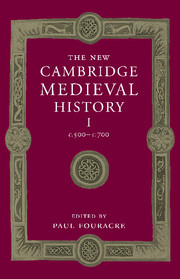Book contents
- Frontmatter
- Introduction: the history of Europe 500–700
- 1 The later Roman Empire
- 2 The Barbarian invasions
- 3 The sources and their interpretation
- PART I THE SIXTH CENTURY
- 4 The Eastern Empire in the sixth century
- 5 The Byzantines in the West in the sixth century
- 6 Ostrogothic Italy and the Lombard invasions
- 7 The formation of the Sueve and Visigothic kingdoms in Spain
- 8 Merovingian Gaul and the Frankish conquests
- 9 The Celtic kingdoms
- 10 The earliest Anglo-Saxon kingdoms
- PART II THE SEVENTH CENTURY
- PART III THEMES AND PROBLEMS
- List of Primary sources
- Bibliography of secondary works arranged by chapter
- Index
- Frontispiece"
- Plate section"
- Map 3 Gaul/Francia in the sixth and seventh centuries"
- References
7 - The formation of the Sueve and Visigothic kingdoms in Spain
from PART I - THE SIXTH CENTURY
Published online by Cambridge University Press: 28 March 2008
- Frontmatter
- Introduction: the history of Europe 500–700
- 1 The later Roman Empire
- 2 The Barbarian invasions
- 3 The sources and their interpretation
- PART I THE SIXTH CENTURY
- 4 The Eastern Empire in the sixth century
- 5 The Byzantines in the West in the sixth century
- 6 Ostrogothic Italy and the Lombard invasions
- 7 The formation of the Sueve and Visigothic kingdoms in Spain
- 8 Merovingian Gaul and the Frankish conquests
- 9 The Celtic kingdoms
- 10 The earliest Anglo-Saxon kingdoms
- PART II THE SEVENTH CENTURY
- PART III THEMES AND PROBLEMS
- List of Primary sources
- Bibliography of secondary works arranged by chapter
- Index
- Frontispiece"
- Plate section"
- Map 3 Gaul/Francia in the sixth and seventh centuries"
- References
Summary
The assassination of the emperor Valentinian III, the last representative of the Theodosian dynasty in 455, and the subsequent sack of Rome by the Vandal Genseric, signal the beginning of a profound political crisis in the western provinces of the Roman Empire. The intensification of military activity because of the hostilities of the barbarian foederati, and the differing interests of Gaulish and Italo-Roman senatorial aristocracies, led to the triumph of centrifugal tendencies, which would result in the end of the Roman imperial state in the West and its replacement by Romano-Germanic kingdoms. Thus for Hispania, as for the rest of the western provinces of the Empire, there began a period of political and military instability, which would eventually distance it from the networks of central power, making way for new regional powers. This process worked not only to the advantage of the Sueves, the only barbarian people who had remained in the Iberian peninsula after the departure of the Vandals for Africa in 429 and who by then were firmly established on its western side, but also to that of the Visigoths. Despite their interests being centred in the south of Gaul in the middle of the fifth century, they soon began to spread out into new bases in Hispania, bases that later would allow them to establish a stable political power there and eventually to annex the Sueve kingdom itself in the second half of the sixth century.
Keywords
- Type
- Chapter
- Information
- The New Cambridge Medieval History , pp. 162 - 192Publisher: Cambridge University PressPrint publication year: 2005
References
- 4
- Cited by



